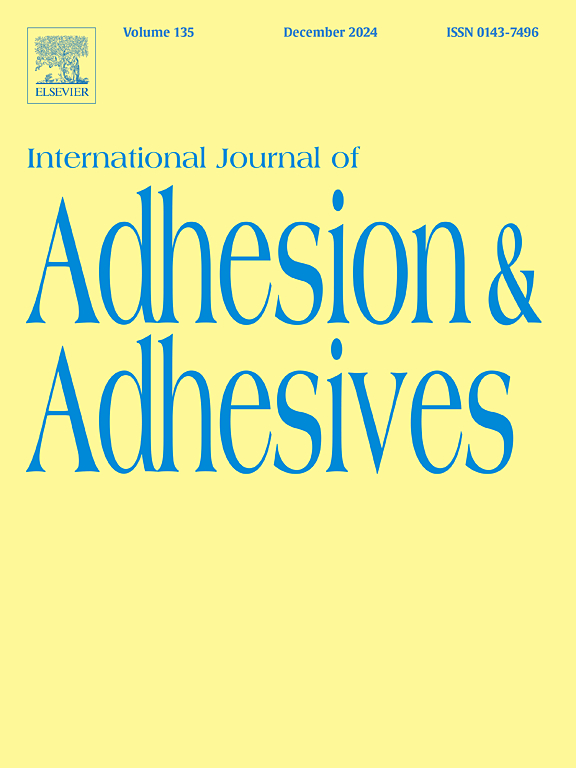On residual mechanical behavior of aluminum-to-composite bonded joints after low velocity transverse impact
IF 3.5
3区 材料科学
Q2 ENGINEERING, CHEMICAL
International Journal of Adhesion and Adhesives
Pub Date : 2025-04-04
DOI:10.1016/j.ijadhadh.2025.104025
引用次数: 0
Abstract
The widespread usage of adhesively bonded joints in advanced engineering structures has increased the importance of developing design concepts under special loading conditions. As bonded connections in wind turbine blade, automotive, and aircraft structures usually experience different types of impact loads, it is important to evaluate residual mechanical performance of bonded joints after these loads. The present research aims to conduct an experimental and numerical investigation on the influence of low-velocity transverse impact with different impact energies of 1 J, 1.5 J, 2 J, and 2.5 J, and two impactor shapes (spherical and cylindrical) on the residual lap shear strength of glass fiber reinforced polymer (GFRP) composite to 2024 aluminum lap bonded joints. The numerical modeling procedure includes two steps of damage, the first induced in the joint due to the transverse impact and the second due to a tensile shear load applied statically. For this purpose, Hashin damage criterion and cohesive zone damage model were implemented to simulate post-impact damage in the composite and adhesive layer and after applying the lap shear loading. Results revealed that, for a low impact energy of 1 J, there is no significant loss of strength for both impactors, while, for other impact energies, the residual strength of the joints impacted by the spherical impactor was lower than that of the cylindrical one, specially for higher impact energies. It was found that the error between numerical and experimental results was greater for specimens impacted by spherical impactor compared to the cylindrical one. Finally, it was deduced that, under high impact energies, the impact energy contributed in causing matrix damage in the composite substrate rather than inducing damage in the adhesive layer.
低速横向冲击后铝-复合材料粘结接头残余力学行为研究
粘接接头在先进工程结构中的广泛应用,增加了开发特殊荷载条件下设计理念的重要性。由于风力涡轮机叶片、汽车和飞机结构中的粘结连接通常会经历不同类型的冲击载荷,因此评估这些载荷后粘结连接的残余力学性能非常重要。本文通过实验和数值研究了低速横向冲击(冲击能分别为1 J、1.5 J、2 J和2.5 J)以及两种冲击器形状(球形和圆柱形)对GFRP复合材料对2024铝合金搭接接头残余搭接剪切强度的影响。数值模拟过程包括两步损伤,第一步是由横向冲击引起的,第二步是由静力施加的拉伸剪切载荷引起的。为此,采用Hashin损伤准则和黏结区损伤模型模拟复合材料层和粘结层及搭接剪切加载后的冲击后损伤。结果表明,在低冲击能量为1 J时,两种冲击器的强度损失均不明显,而在其他冲击能量下,球形冲击器撞击关节的残余强度低于圆柱形冲击器,特别是在高冲击能量时。结果表明,与圆柱形冲击器相比,球形冲击器冲击试样的数值与实验结果的误差更大。最后,推导出在高冲击能量下,冲击能量对复合材料基体的损伤作用大于对粘结层的损伤作用。
本文章由计算机程序翻译,如有差异,请以英文原文为准。
求助全文
约1分钟内获得全文
求助全文
来源期刊

International Journal of Adhesion and Adhesives
工程技术-材料科学:综合
CiteScore
6.90
自引率
8.80%
发文量
200
审稿时长
8.3 months
期刊介绍:
The International Journal of Adhesion and Adhesives draws together the many aspects of the science and technology of adhesive materials, from fundamental research and development work to industrial applications. Subject areas covered include: interfacial interactions, surface chemistry, methods of testing, accumulation of test data on physical and mechanical properties, environmental effects, new adhesive materials, sealants, design of bonded joints, and manufacturing technology.
 求助内容:
求助内容: 应助结果提醒方式:
应助结果提醒方式:


